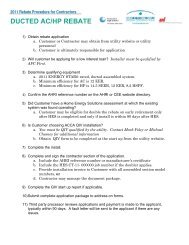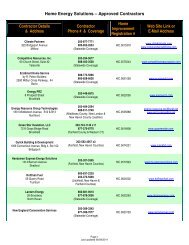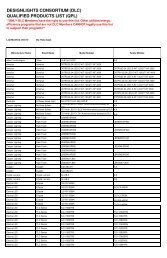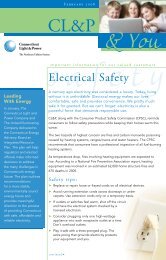here - Northeast Utilities
here - Northeast Utilities
here - Northeast Utilities
Create successful ePaper yourself
Turn your PDF publications into a flip-book with our unique Google optimized e-Paper software.
RESULTS OF CL&P PLAN-IT WISE ENERGY PILOT<br />
Docket No. 05-10-03RE01<br />
Compliance<br />
Order No. 4<br />
The TOU Pilot rate tested response from noon to 8 p.m. weekdays as the on-peak period, and all other<br />
hours as the off-peak period. Under this test the price differential for on-peak versus off-peak was<br />
substantially wider than the TOU pricing which exists currently in CL&P’s TOU rates.<br />
Price Differentials and Technology Scenarios<br />
For each of the Pilot rate structures, both a “high” and “low” price differential was tested. That is, for the<br />
CPP, the rate during critical peak hours was increased by about $0.65 and $1.60 per kWh over the<br />
otherwise applicable flat tariff rates for the low and high price programs, respectively. The higher critical<br />
peak pricing enabled all other hours under the CPP program to be reduced. For the high and low PTR<br />
structures, the rebate offered was approximately the same value per kWh as the CPP rate increases. For<br />
the TOU structures, the high price program included an on-peak versus off-peak differential of $0.20 per<br />
kWh, and the low price program included a $0.10 per kWh differential. Table 1 summarizes the rate<br />
differentials tested during the Pilot.<br />
Customers<br />
Residential<br />
(Rate 1 & 5)<br />
TABLE 1 – Rate price differentials by rate design<br />
RATE-><br />
TOU<br />
PTR<br />
CPP<br />
Period<br />
Low<br />
High<br />
Low<br />
High<br />
Low<br />
High<br />
Peak<br />
0.071<br />
0.142<br />
0.655<br />
1.614<br />
0.655<br />
1.614<br />
Off-Peak<br />
-0.029<br />
-0.058<br />
0.000<br />
0.000<br />
-0.015<br />
-0.036<br />
C&I<br />
(Rate 30 & 35)<br />
Peak<br />
Off-Peak<br />
0.069<br />
-0.031<br />
0.138<br />
-0.062<br />
0.650<br />
0.000<br />
1.601<br />
0.000<br />
0.650<br />
-0.020<br />
1.601<br />
-0.049<br />
Further, within each of these Pilot pricing tests, customers were included either with or without<br />
technology. Non-technology customer groups were provided only the price signals from the Pilot<br />
programs. The technology customers received various devices designed to measure differences in the<br />
peak load response within the Pilot. The technologies were either “enabling,” such as an automatic or<br />
smart switch device on central air conditioners or an automatic set-back thermostat or smart thermostat<br />
(both designed to increase temperature settings during events), or “passive” technology providing<br />
information as to when events were occurring. Two informational non-controlling devices were used in<br />
the Pilot, the Energy Orb and the Power Cost Monitor in-home display.<br />
Customer Enrollment<br />
CL&P executed a marketing and enrollment process designed to achieve demographic diversity and<br />
statistical significance. To test the three Pilot rates with two price differentials, with and without<br />
technology, the Company designed 13 groups of 100 customers each for both Residential and C&I<br />
customers (a total of 2,600 customers). The enrollment process targeted participation of 1,300<br />
Residential customers and 1,300 commercial and industrial (“C&I”) customers through the end of the<br />
Pilot. To ensure statistical validity, the Company over-enrollment by 17 percent,(i.e., 117 customers<br />
signed up in each “test cell”, to accommodate customer move-ins, move-outs and drop-outs, making the<br />
total targeted enrollment number approximately 2800, plus approximately 100 customers in the C&I and<br />
100 customers in the Residential control groups. Customers were able to opt-out at any time. To<br />
maintain statistical validity, customers were not able to choose among, or switch between, Pilot rates<br />
during the Pilot. Please see Appendix A, pages 21 and 22, for information that details the various Pilot<br />
treatment cells tested as they relate to the number of customers that received different technologies.<br />
Page 6 of 11










